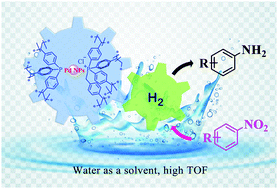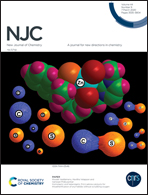Pd nanoparticles stabilized with phosphine-functionalized porous ionic polymer for efficient catalytic hydrogenation of nitroarenes in water†
Abstract
Small palladium nanoparticles stabilized with phosphine-functionalized porous ionic polymer (Pd@P(QP-TVP)) were successfully prepared through a free-radical copolymerization, successive anion-exchange and chemical reduction method. Physicochemical characterization studies suggested that the prepared catalyst featured large surface area, a hierarchically porous structure, amphiphilic surface wettability, and strong electron interaction between Pd nanoparticles and the polymer scaffold. We demonstrated the use of the solid catalyst for water-mediated reduction of nitrobenzene with H2 as a hydrogen source. Notably, a low Pd dosage was sufficient for a high yield (99.7%) of aniline with a remarkable turnover frequency (TOF) of 5982 h−1. Furthermore, the Pd@P(QP-TVP) catalyst can be easily recovered and reused at least 5 times without significant loss of activity. Additionally, a number of functional nitroarenes can be efficiently transformed to arylamines in high yields under optimal conditions. Thus, this work provided a highly active, stable and heterogeneous Pd catalyst for the environmentally benign and cost-effective hydrogenation of nitroarenes.



 Please wait while we load your content...
Please wait while we load your content...